A Study on Non-Contact Multi-Sensor Fusion Online Monitoring of Circuit Breaker Contact Resistance for Operational State Awareness
Abstract
1. Introduction
2. Measurement Principles and Influencing Factors of Circuit Breaker Circuit Resistance
2.1. Basic Theory of Resistance
2.1.1. Differences Between DC Resistance and AC Resistance
2.1.2. Analysis of Power Frequency (50/60 Hz) Resistance Characteristics
2.2. Contact Performance and the Effect of Temperature
2.2.1. Characteristics of Contact Materials
2.2.2. The Effect of Temperature on Resistance
2.3. Wear and Thermal Effects of Current
2.3.1. The Effect of Mechanical Wear on Resistance
2.3.2. The Impact of Current–Heat Effect
2.4. Ambient Factors and Contact Pressure
2.4.1. The Role of Ambient Environment and Medium
2.4.2. The Effect of Contact Pressure on Resistance
3. Development of Non-Contact Online Monitoring Technology
3.1. System Design and Architecture
3.1.1. Design Objectives and Technical Implementation
- High real-time monitoring.
- 2.
- High-precision dynamic measurement.
- 3.
- Anti-interference and engineering reliability.
- 4.
- Engineering applicability.
- 5.
- Reliability assurance.
3.1.2. System Architecture and Multi-Sensor Fusion
3.1.3. Multi-Sensor Collaborative Working Mechanism
3.2. Sensors and Data Acquisition
3.2.1. Selection and Performance Optimization of Hall Sensors
3.2.2. Indirect Measurement Technology for Contact Temperature
- Thermal network model and temperature calculation.
- 2.
- Ambient interference suppression technology.
- 3.
- Data error correction method.
3.2.3. Anti-Interference Capability for Electric Field Sensors
- Anti-interference hardware design.
- 2.
- Wavelet denoising algorithm.
- 3.
- Differential signal processing workflow.
3.3. High-Precision Data Processing and Algorithm Implementation
3.3.1. Dynamic Temperature Compensation Algorithm Based on Thermodynamic Modeling
3.3.2. Dynamic Resistance Extraction Algorithm
3.3.3. Anomaly Detection and Early Warning Mechanism
3.4. System Communication and Integration
3.4.1. NB-IoT Communication Module
3.4.2. Low Power Design and Electromagnetic Compatibility Optimization
- The microcontroller uses an intermittent operating mode.
- 2.
- Electromagnetic compatibility (EMC) optimization.
4. Experimental Verification and Result Analysis
4.1. Experimental Platform and Testing Scheme
- Hardware configuration and testing environment.
- 2.
- Sensor modules and system components.
- 3.
- Data acquisition and test scenario design.
4.2. Comparison of Online Monitoring Data and Performance Analysis
- Real-time testing.
- 2.
- Interference resistance performance analysis.
4.3. Application Cases and System Reliability
- Practical application case: a 110 kV substation.
- 2.
- System reliability validation and performance evaluation.
4.4. Key Experimental Results
- Experimental results overview.
- 2.
- Results Analysis and Summary
5. Discussion
5.1. Summary of Key Experimental Results
- Analysis of technical limitations.
- 2.
- Engineering application adaptability issues.
5.2. Future Research Directions
6. Conclusions
Author Contributions
Funding
Data Availability Statement
Conflicts of Interest
References
- Fan, X.M.; Xu, H.H.; Li, T.; Zhang, X. Fault Diagnosis of High-voltage Circuit Breakers Based on SMA-VMD and Energy Entropy. High Volt. Eng. 2024, 50, 5248–5258. [Google Scholar]
- Li, F.; Wang, C.L.; Zhang, W.W. Research on Online Monitoring Methods for Operational Hazards of High-voltage Equipment in Distribution Network. Power Electron. 2025, 59, 65–69. [Google Scholar]
- Zhang, B.G.; Wang, C.T.; Huang, W.M. Fault Diagnosis Method of Circuit Breaker Based on Multi-source Sensor Data Fusion. High Volt. Eng. 2025, 51, 660–668. [Google Scholar]
- Lan, L.; Chen, G.; Wen, X.H.; Wu, Y. Erosion Characteristics of SF6 Circuit Breaker Contacts Based on Dynamic Contact Resistance Measurement. High Volt. Eng. 2016, 42, 1731–1738. [Google Scholar]
- Wang, Z.X.; Diao, M.X.; Xiao, G.Y.; Yan, J.; Chen, D.P.; Chen, B.F. SF6 Circuit Breaker Contact State Assessment Based on QPSO-SVR Algorithm. High Volt. Eng. 2023, 49, 3907–3917. [Google Scholar]
- Peng, Z.X. Study on the Technical Strategy of On-line Monitoring for High Voltage Switchgear. High Volt. Appar. 2015, 51, 132–137. [Google Scholar]
- Li, P. Analysis of circuit resistance measurement method of 1000kV UHV circuit breaker. China Plant Eng. 2024, 22, 165–167. [Google Scholar]
- Li, X.W.; Lu, Q.F.; Lu, H.; Wang, Y.; Wang, L.H. Online Monitoring Technique and Application of UHF during Partial Discharge of GIS. Guangdong Electr. Power 2012, 25, 91–95. [Google Scholar]
- Chen, L.; Duan, Y. Application of Online Monitoring Technology in Smart Grid Transmission Lines. Electron. Technol. 2023, 52, 332–333. [Google Scholar]
- Zhu, Y.C.; Zhang, P.; Tian, Y.; Huang, X.B. Synchronous Acquisition in Online Monitoring Technology for Substation Equipment Comparative analysis of triggering methods. Electr. Power 2022, 55, 64–73. [Google Scholar]
- Jiang, Y.H.; Zhu, H.; Jiang, X.W. Design and Software Development of Transformer Online Monitoring System Based on Multi-Source Information Fusion. Comput. Appl. Softw. 2025, 42, 48–53+80. [Google Scholar]
- Wang, Z.M.; Li, P.; Wei, J.; Liu, S.R.; Zhang, W.X.; Zhong, M.S.; Li, Z.B. Research on Transmission Line Monitoring Based on Edge Computing and Multi-Sensor Fusion. Comput. Meas. Control 2023, 31, 113–118. [Google Scholar]
- Lindsrad, P.A.; Huber, C.N.; Garavan, M.F. Non-Contact Voltage Measurement System. CN Patent 108072782 B, 4 January 2022. [Google Scholar]
- Zhao, X.; Wu, G.; Yang, D.; Xu, G.; Xing, Y.; Yao, C.; Abu-Siada, A. Enhanced detection of power transformer winding faults through 3D FRA signatures and image processing techniques. Electr. Power Syst. Res. 2025, 242, 111433. [Google Scholar] [CrossRef]
- Zhao, K.; Li, Y.J.; Liang, Z. A new online monitoring application for high voltage switch based on non-contact current sensor. E3S Web Conf. 2021, 233, 01054. [Google Scholar] [CrossRef]
- Sousa, S.D.F.H.; Oliveira, D.C.A.; Xavier, R.V.G. Analysis of alternative parameters of dynamic resistance measurement in high voltage circuit breakers. High Volt. 2019, 4, 197–202. [Google Scholar] [CrossRef]
- Chen, K.L.; Guo, Y.; Ma, X.Y. Contactless voltage sensor for overhead transmission lines. IET Gener. Transm. Distrib. 2018, 12, 957–966. [Google Scholar] [CrossRef]
- Cui, J.X.; Wu, H.X.; Nan, B.F. Research and Application of Non-contact On-line Monitoring Technology of Cable Based on FVMD & WVD Method. High Volt. Appar. 2024, 60, 205–214+220. [Google Scholar]
- Wu, Y.M.; Xu, S.D.; Jiang, M. Non-contact current measurement method for removing eccentricity error with magnetic array sensors. Transducer Microsyst. Technol. 2024, 43, 133–136. [Google Scholar]
- Feng, D.; Liu, H.; Li, J.X. Non-contact Voltage Measurement Method of Transmission Line Based onElectric Field Sensor Array. High Volt. Eng. 2024, 50, 292–301. [Google Scholar]
- Zhang, Z.L. Research and Development of Non-Contact Voltage Measuring Device Based on Electrie Field Coupling; South China University of Technology: Guangzhou, China, 2023. [Google Scholar]
- Wu, R.-D.; Jiao, Z.-B.; Liu, T.; Dong, X.-M.; Lei, X. A new method to improve fault location accuracy in transmission line based on fuzzy inference data fusion technology. In Proceedings of the 2016 IEEE PES Asia-Pacific Power and Energy Engineering Conference (APPEEC), Xi’an, China, 25–28 October 2016; pp. 1486–1490. [Google Scholar]
- Ma, G.; Mao, N.; Li, Y.; Jiang, J.; Zhou, H.; Li, C. The Reusable Load Cell with Protection Applied for Online Monitoring of Overhead Transmission Lines Based on Fiber Bragg Grating. Sensors 2016, 16, 922. [Google Scholar] [CrossRef]
- Cui, Y.H.; Xu, Y.P.; Wang, L.J. Nonlinear Dynamic Compensation for Probability Analysis in Fault Diagnosis of Electric Equipment. Appl. Mech. Mater. 2014, 2963, 913–916. [Google Scholar] [CrossRef]
- GB/T 24838-2018; 1100 kV High-Voltage Alternating-Current Circuit-Breakers. Standardization Administration of China: Beijing, China, 2018.
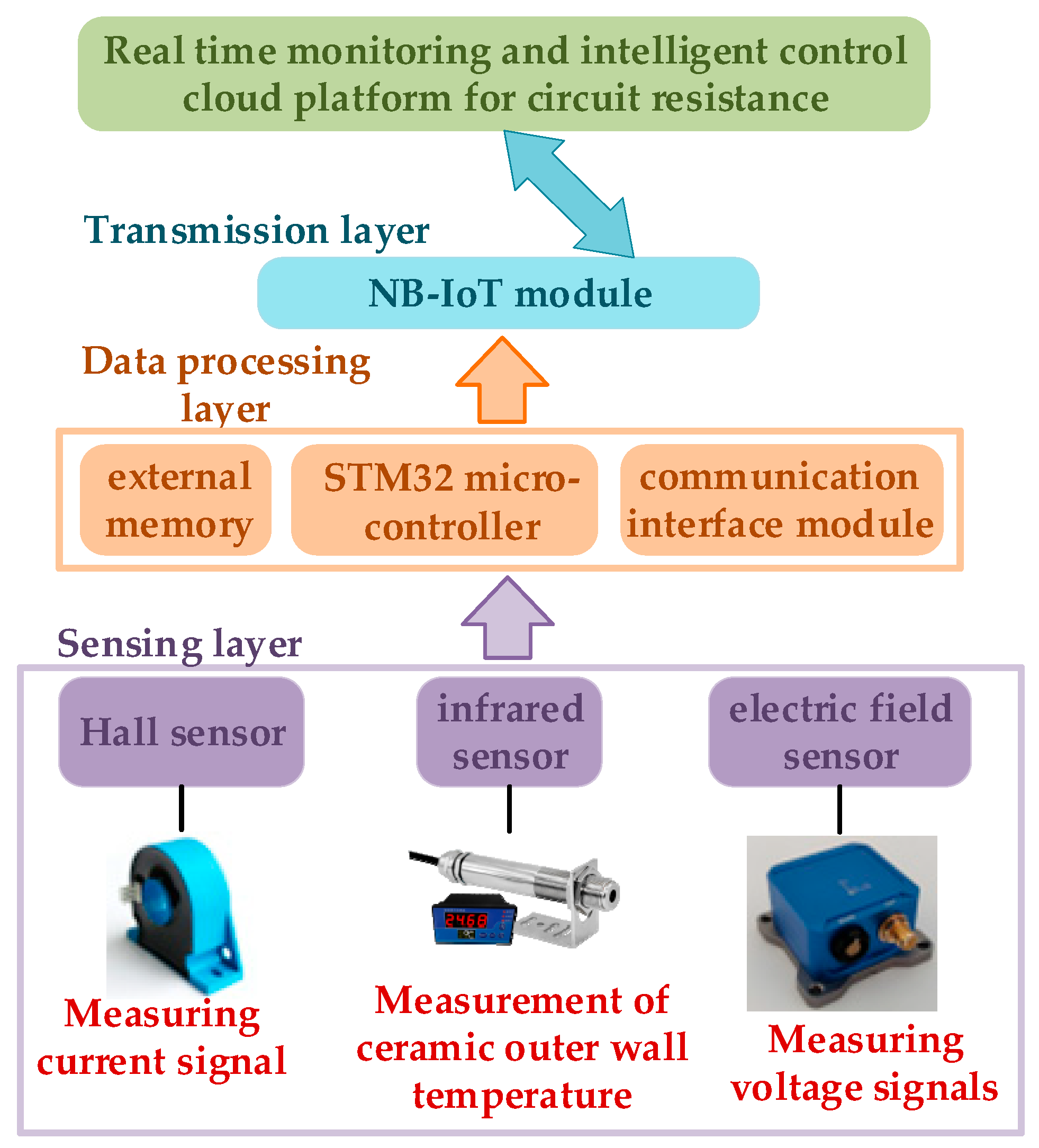
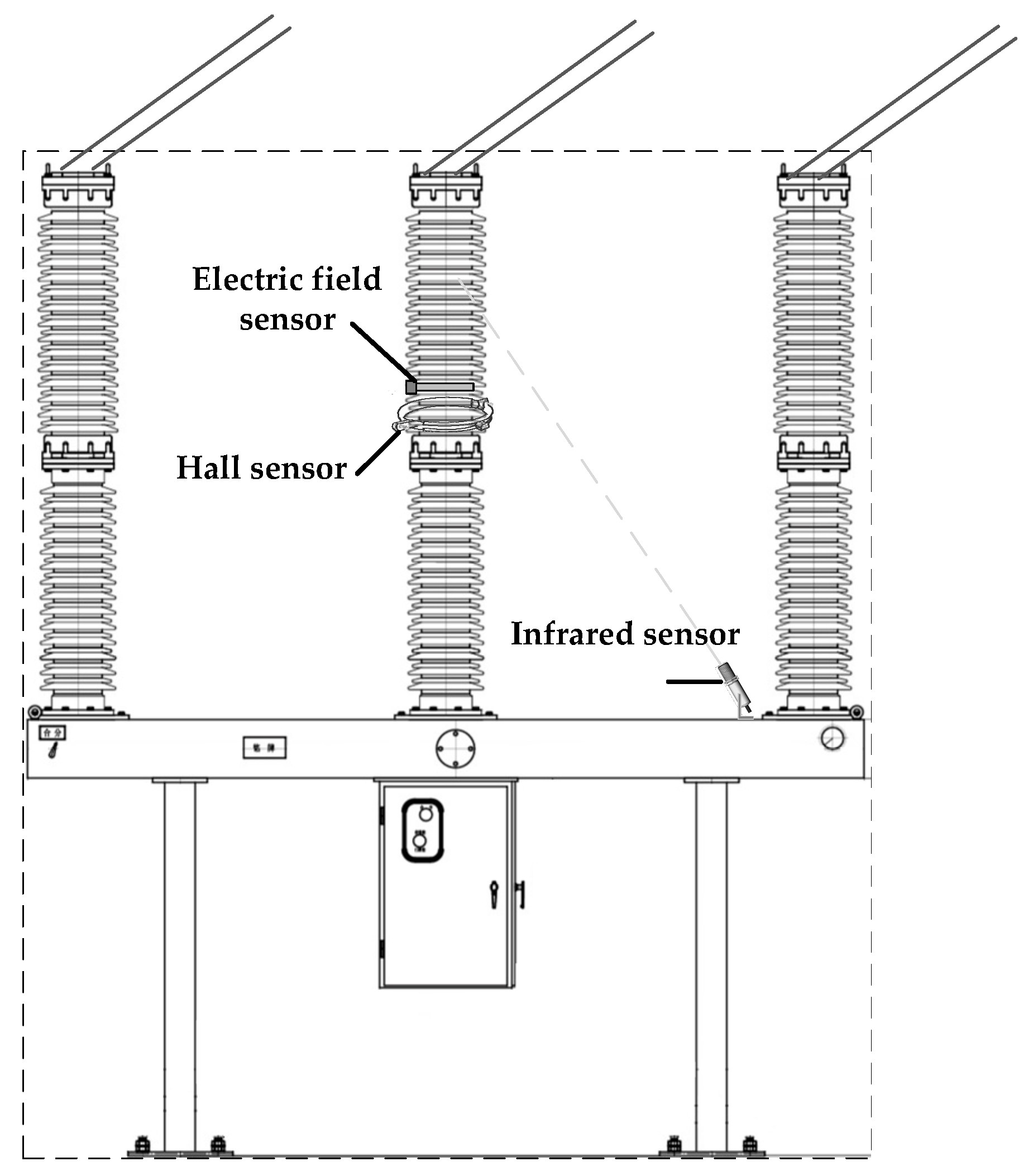
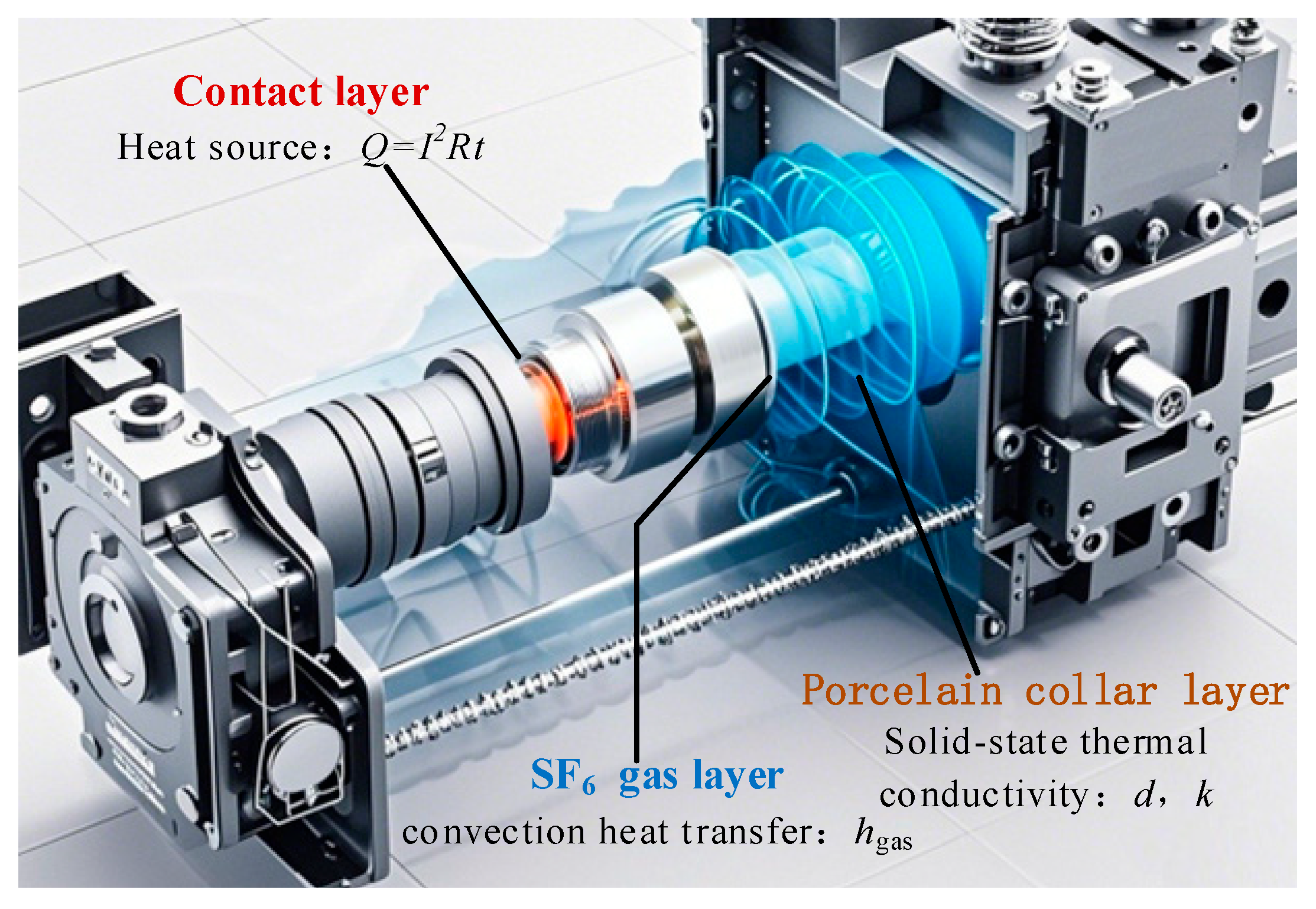

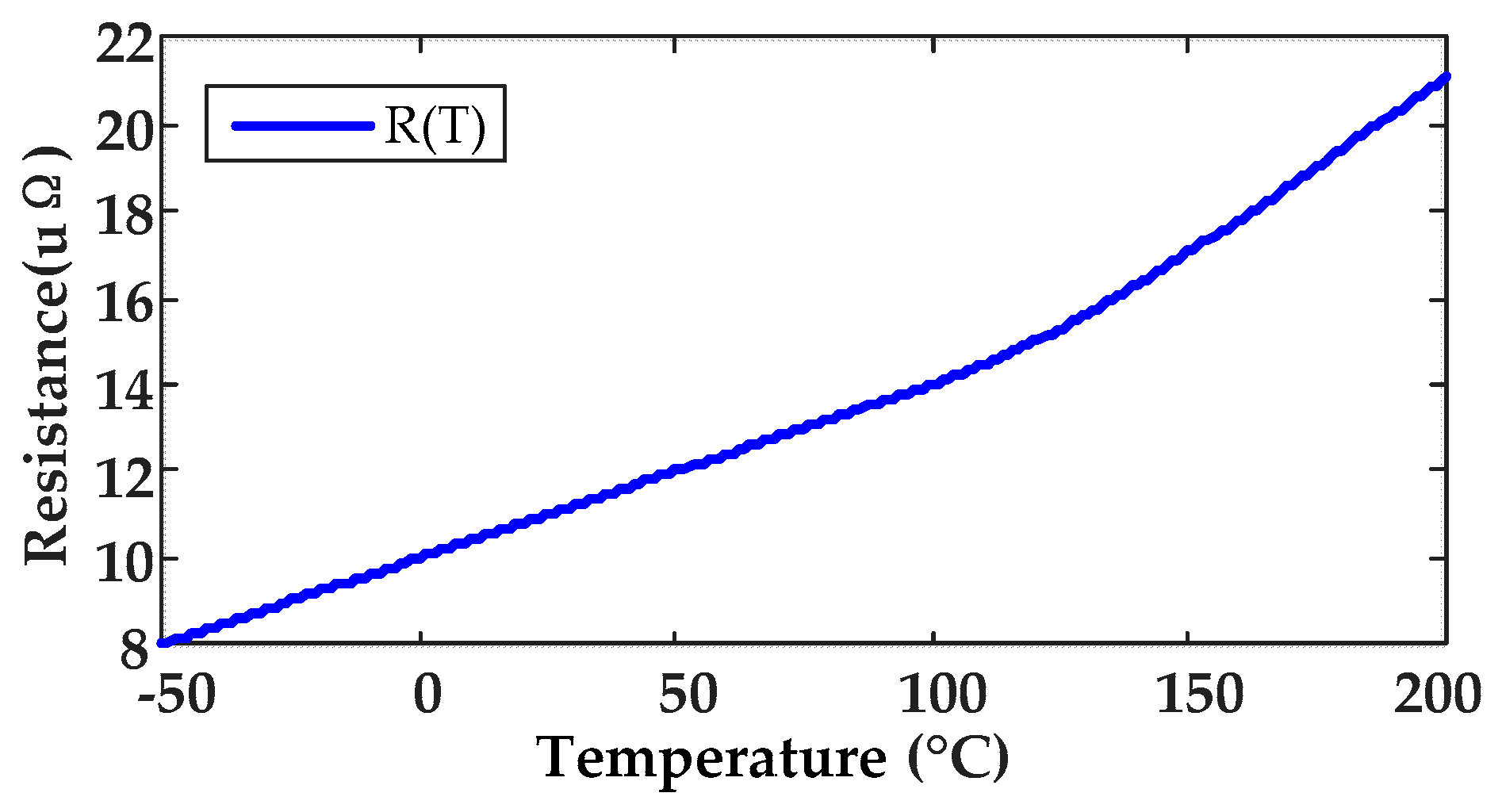
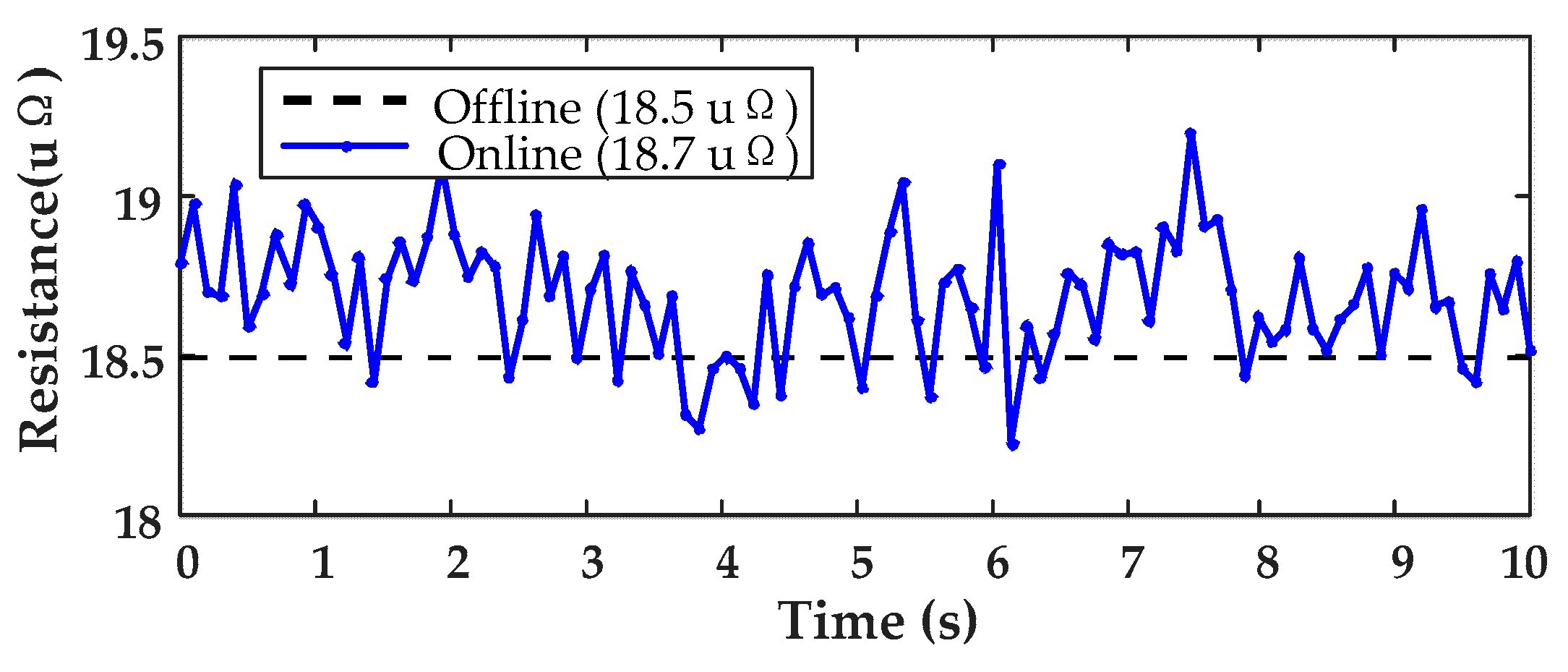
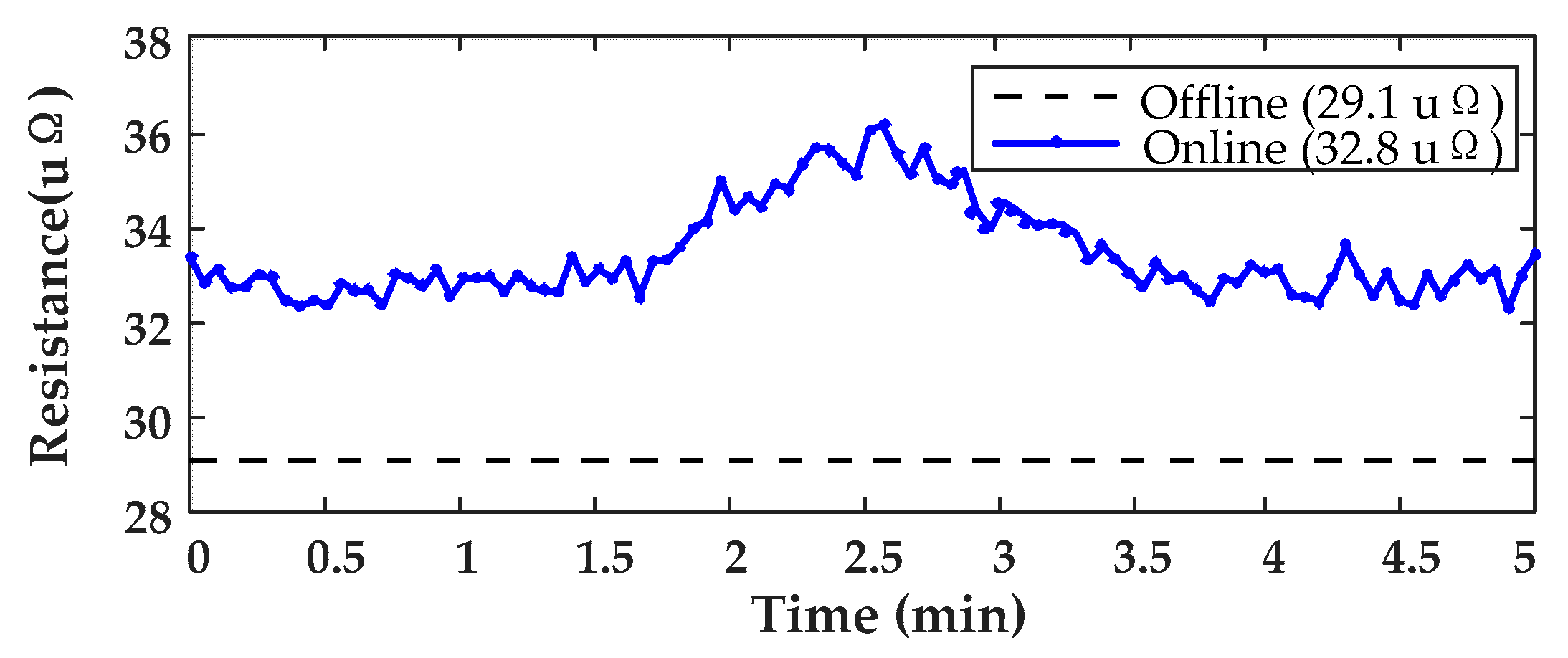
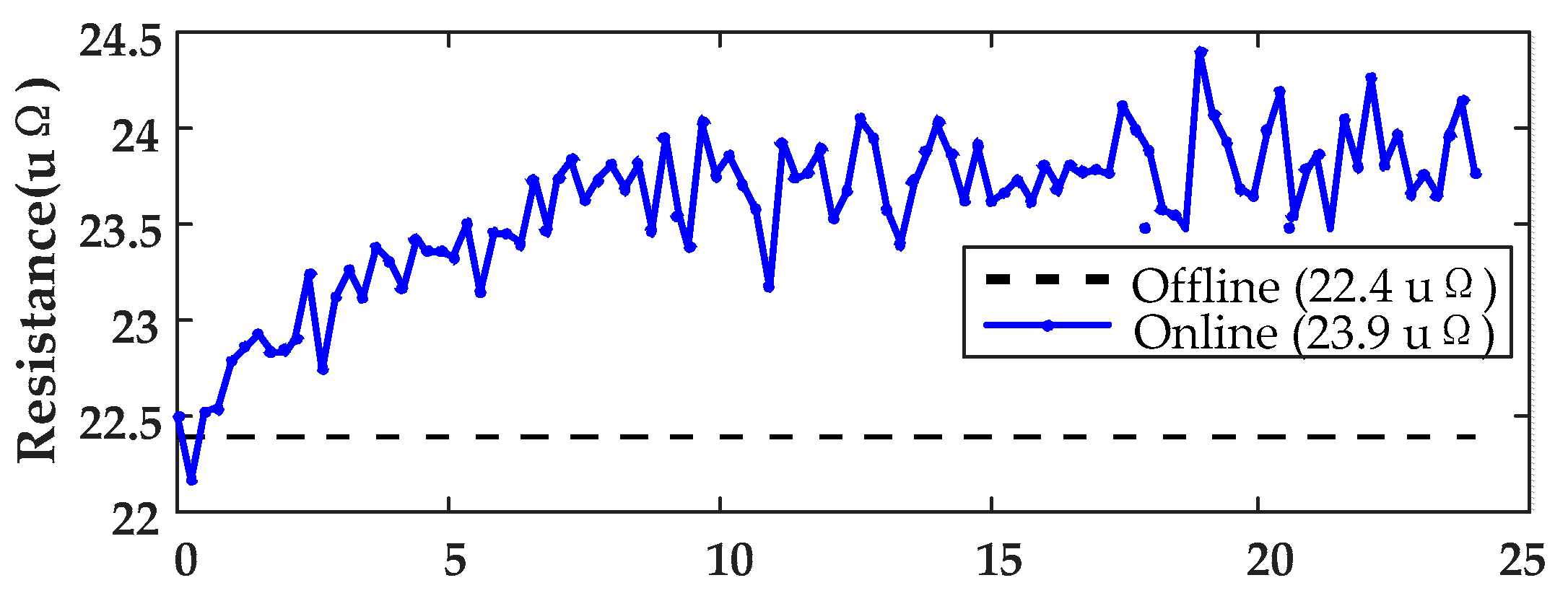
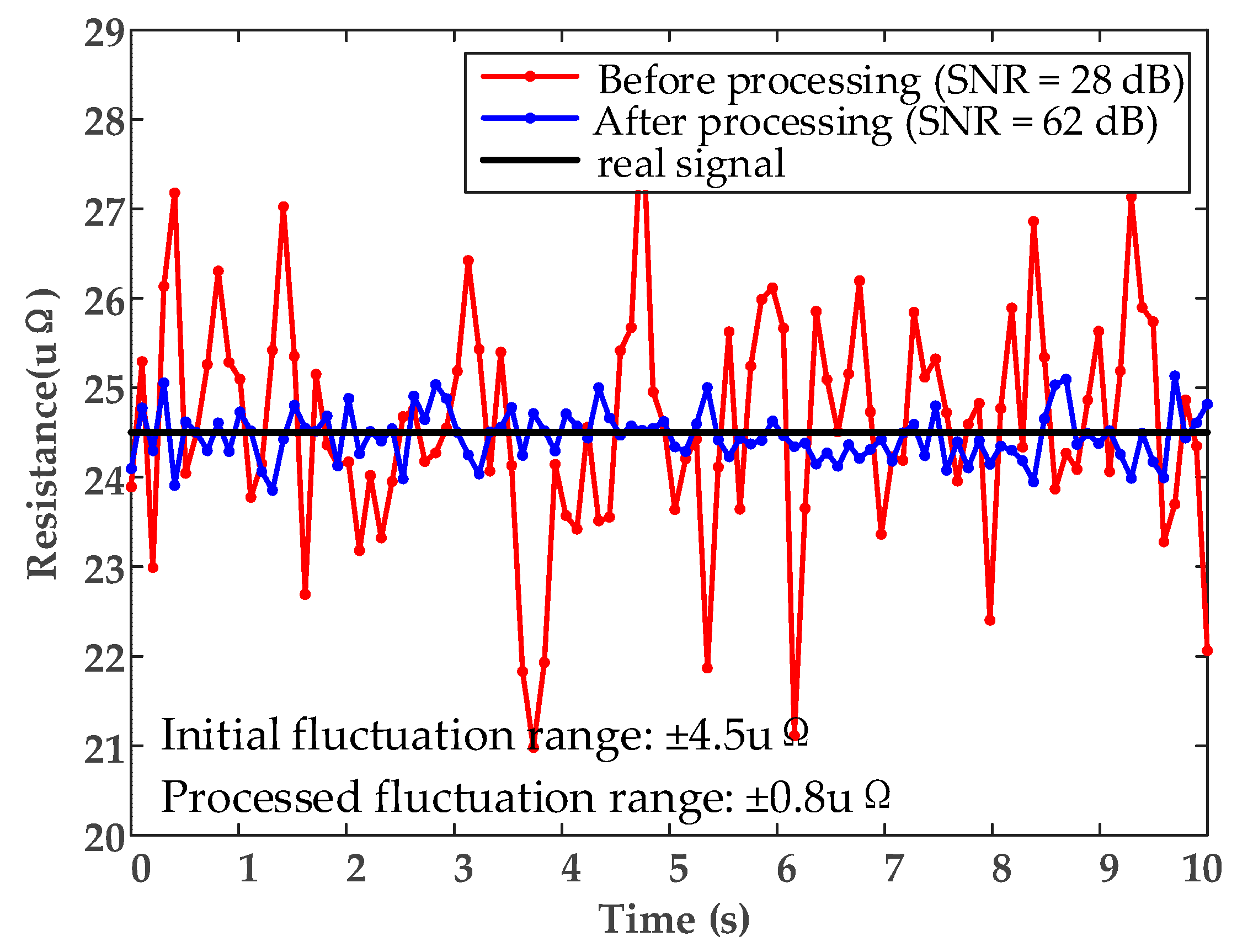
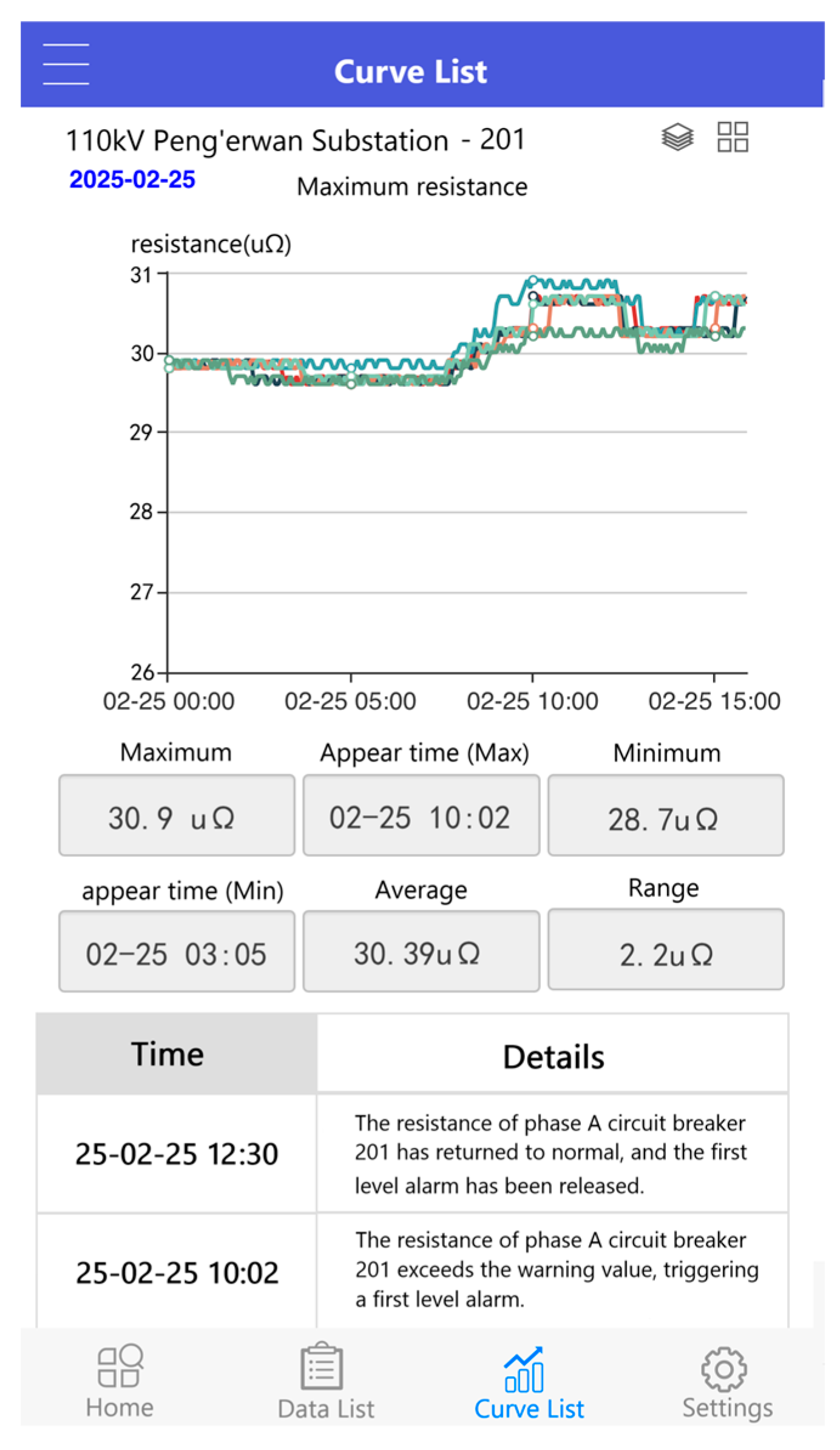
| Test Scenarios | Offline Monitoring Mean Value (μΩ) | Online Monitoring Mean Value (μΩ) | Error Rate (%) |
|---|---|---|---|
| Scenario 1 | 18.5 | 18.7 | 1.1 |
| Scenario 2 | 29.1 | 32.8 | 12.3 |
| Scenario 3 | 22.4 | 23.9 | 6.7 |
| Comparison Dimensions | Traditional Offline Measurement Methods | The Contactless Online Monitoring System in This Paper |
|---|---|---|
| Response Speed | 3-Year Maintenance Interval | ≤200 ms |
| Measurement Error | Scenario 2 Overload Surge Error Reaches 12.3% | Comprehensive Average Error Across All Scenarios <1.5% |
| Anti-Interference Capability | Passive Design Without Active Suppression | SNR > 60 dB |
| Environmental Adaptability | Requires Power Shutdown for Operation | IP67 Protection and Stable Operation at 90% Humidity |
| Cost-Effectiveness | Single-Test Cost: USD 200 + (Excluding Labor Fees) | Unit Hardware Cost: USD 120 |
| Data Integrity Assurance | Reduction of Reliance on Manual Documentation | NB-IoT Transmission Integration |
| Functional Scalability | Single-Resistance Detection Implementation | Multi-Parameter Fusion Implementation |
| Typical Application Scenarios | Periodic Preventive Maintenance | Real-Time Monitoring/Fault Early Warning/Lifetime Prediction |
Disclaimer/Publisher’s Note: The statements, opinions and data contained in all publications are solely those of the individual author(s) and contributor(s) and not of MDPI and/or the editor(s). MDPI and/or the editor(s) disclaim responsibility for any injury to people or property resulting from any ideas, methods, instructions or products referred to in the content. |
© 2025 by the authors. Licensee MDPI, Basel, Switzerland. This article is an open access article distributed under the terms and conditions of the Creative Commons Attribution (CC BY) license (https://creativecommons.org/licenses/by/4.0/).
Share and Cite
Wang, Z.; Zhang, H.; Zhang, Y.; Zhang, H.; Chen, J.; Feng, S.; Guo, J.; Lv, Y. A Study on Non-Contact Multi-Sensor Fusion Online Monitoring of Circuit Breaker Contact Resistance for Operational State Awareness. Energies 2025, 18, 2667. https://doi.org/10.3390/en18102667
Wang Z, Zhang H, Zhang Y, Zhang H, Chen J, Feng S, Guo J, Lv Y. A Study on Non-Contact Multi-Sensor Fusion Online Monitoring of Circuit Breaker Contact Resistance for Operational State Awareness. Energies. 2025; 18(10):2667. https://doi.org/10.3390/en18102667
Chicago/Turabian StyleWang, Zheng, Hua Zhang, Yiyang Zhang, Haoyong Zhang, Jing Chen, Shuting Feng, Jie Guo, and Yanpeng Lv. 2025. "A Study on Non-Contact Multi-Sensor Fusion Online Monitoring of Circuit Breaker Contact Resistance for Operational State Awareness" Energies 18, no. 10: 2667. https://doi.org/10.3390/en18102667
APA StyleWang, Z., Zhang, H., Zhang, Y., Zhang, H., Chen, J., Feng, S., Guo, J., & Lv, Y. (2025). A Study on Non-Contact Multi-Sensor Fusion Online Monitoring of Circuit Breaker Contact Resistance for Operational State Awareness. Energies, 18(10), 2667. https://doi.org/10.3390/en18102667





